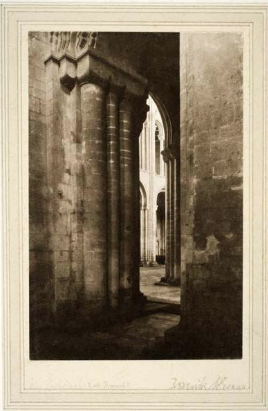Ely Cathedral, S.W. Transept (A Memory of the Normans)

Frederick Henry Evans, Ely Cathedral, S.W. Transept (A Memory of the Normans), published in "Camera Work" (October 1903), ca. 1899 (published 1903), Platinum print, Museum purchase with funds provided by Wellesley College Friends of Art, 1972.14
Just one year before taking this photograph of Ely Cathedral in northeastern England, Frederick Henry Evans retired from his bookselling career to become a full-time photographer. With the annuity from his business, he traveled to photograph his favorite subjects: the cathedrals of France and England.
Evans sought to communicate a spiritual experience in his photographs. At Ely Cathedral, he positioned the camera behind a column at the southwestern transept, one of the arms of the church’s cross structure. Framed by columns and Gothic arches, the dim foreground and middle ground guide the viewer’s eyes to the illuminated nave of the church. The mottled stone walls and the absence of people suggest the nostalgia about the medieval cathedral that Evans shared with his fellow Romantics.
A supporter of purist photography, Evans rejected Pictorialism, the dominant early twentieth-century trend, which sought to imitate paintings through multiple exposures or the addition of colors. Evans believed that the only hope for photography to be recognized as an art lay in the perfection of the process itself. Instead of using post-exposure alterations, the purist photographer spent days studying every location to find the best luminosity and angle that would capture the essence of the space. He also preferred platinum prints for their subtle and expansive tonal values, and he eventually gave up photography when platinum paper was no longer in supply.